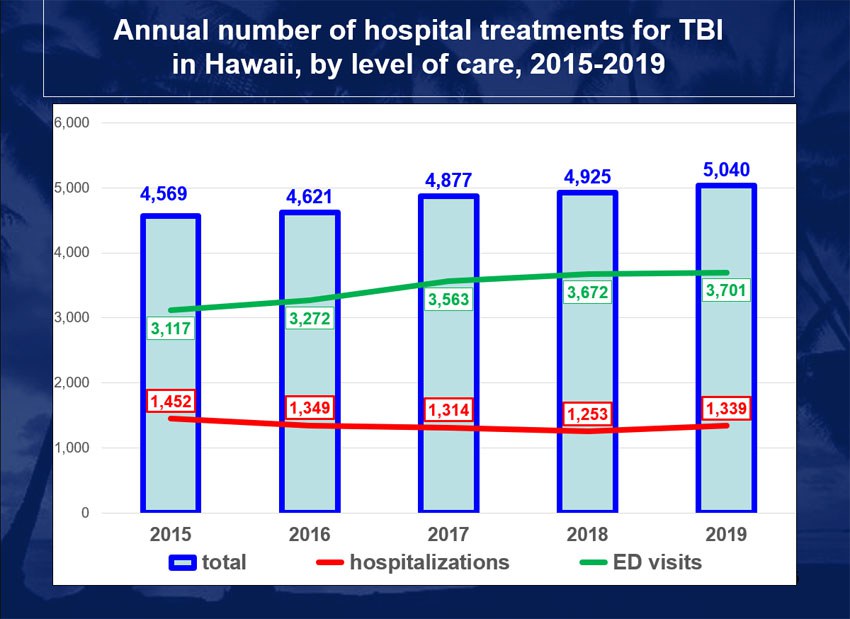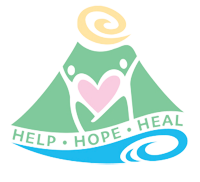Traumatic Brain Injury (TBI)
Overview
Traumatic brain injury (TBI) is a major cause of death and disability in the United States. From 2006 to 2014, the number of TBI-related emergency department visits, hospitalizations, and deaths increased by 53%. In 2014, an average of 155 people in the United States died each day from injuries that include a TBI. Those who survive a TBI can face effects that last a few days, or the rest of their lives. Effects of TBI can include impairments related to thinking or memory, movement, sensation (e.g., vision or hearing), or emotional functioning (e.g., personality changes, depression). The devastating effects from a TBI have compromised survivors’ abilities to contribute to their family and community both economically and emotionally.
Traumatic Brain Injury Facts
What is a TBI?
A TBI is caused by a bump, blow, or jolt to the head that disrupts the normal function of the brain. Not all blows or jolts to the head result in a TBI. The severity of a TBI may range from “mild” (i.e., a brief change in mental status or consciousness) to “severe” (i.e., an extended period of unconsciousness or memory loss after the injury). Most TBIs that occur each year are mild, commonly called concussions.
How many people have TBI in Hawaii?
From 2015 to 2019, there was an annual average of 4,806 TBIs, including 1,341 hospitalizations and 3,465 emergency department (ED) visits in Hawaii.
Figure 1: Annual Number of Hospital Treatments for TBI in Hawaii, by Level of Care, 2015-2019.

Number of hospital treatments in Hawaii by level of care – Long Description
What are the leading causes of TBI in Hawaii?
Unintentional falls was the leading cause of TBI at each level of severity, accounting for more than half of the nonfatal injuries and 45% of deaths that involved a TBI. Most of the fatal falls (81%) and those requiring hospitalization (70%) occurred among senior-aged residents (those 65 years and older), while patients under 15 years of age comprised 23% of the fall-related TBI treated in ED settings. Motor vehicle crash was a common cause of fatalities and hospitalizations, while being unintentionally struck by or against something was a more prevalent cause of TBI-related ED visits. The average duration for hospitalizations was 7 days and resulted in an approximate average of $50,800 in medical charges ($70.9 million/year). Each TBI-related ED visit generated almost $3,200 in medical charges (a total of $35.1 million/year).
Risk Factors of TBI
Among TBI-related deaths in 2014:
- Rates were highest for persons 75 years of age and older.
- The leading cause of TBI-related death varied by age:
- Falls were the leading cause of death for persons 65 years of age or older.
- Intentional self-harm was the leading cause of death for persons 45-64 years of age.
- Motor vehicle crashes were the leading cause of death for persons 15-24, 25-34, and older adults aged ≥75 years.
- Homicide was the leading cause of death for children ages 0-4 years.
Among TBI-related ED visits and hospitalizations in 2014:
- Hospitalization rates were highest among persons 75 years of age and older.
- Rates of ED visits were highest for persons 75 years of age and older and children 0-4 years of age.
- The leading cause of TBI-related ED visits varied by age:
- Falls were the leading cause of ED visits among young children aged 0 to 4 years and older adults 65 years and older.
- Being struck by or against an object was highest among those 5 to 14 years of age.
- The leading cause of TBI-related hospitalizations varied by age:
- Falls were the leading cause of hospitalizations among children 0 to 17 years and adults 55 years of age and older.
- Motor vehicle crashes were the leading cause of hospitalizations for adolescents and adults aged 15 to 44 years of age.
TBI Prevention Tips
- Buckle Up Every Ride – Wear a seat belt every time you drive – or ride – in a motor vehicle.
- Never drive while under the influence of alcohol or drugs.
- Wear a helmet, or appropriate headgear, when you or your children:
- Ride a bike, motorcycle, snowmobile, scooter, or use an all-terrain vehicle;
- Play a contact sport, such as football, ice hockey, or boxing;
- Use in-line skates or ride a skateboard;
- Bat and run bases in baseball or softball;
- Ride a horse; or
- Ski or snowboard.
- Prevent Older Adult Falls
- Talk to your doctor to evaluate your risk for falling and talk with them about specific things you can do to reduce your risk for a fall.
- Ask your doctor or pharmacist to review your medicines to see if any might make you dizzy, sleepy or interact negatively with other medications. This should include prescription medicines, over-the counter medicines, herbal supplements, and vitamins.
- Have your eyes checked at least once a year and be sure to update your eyeglasses if needed.
- Do strength and balance exercises to make your legs stronger and improve your balance.
- Make your home safer.
- Talk to your doctor to evaluate your risk for falling and talk with them about specific things you can do to reduce your risk for a fall.
- Make living and play areas safer for children
- Install window guards to keep young children from falling out of open windows.
- Use safety gates at the top and bottom of stairs when young children are around.
- Make sure your child’s playground has soft material under it, such as hardwood mulch or sand.
TBI Symptoms
Most people with a TBI recover well from symptoms experienced at the time of the injury. Most TBIs that occur each year are mild, commonly called concussions, which is a mild TBI. But for some people, symptoms can last for days, weeks, or longer. In general, recovery may be slower among older adults, young children, and teens. Those who have had a TBI in the past are also at risk of having another one. Some people may also find that it takes longer to recover if they have another TBI.
Symptoms Usually Fall into Four Categories:
| Thinking/Remembering | Physical | Emotional/Mood | Sleep |
|---|---|---|---|
| Difficulty thinking clearly | Headache Fuzzy or blurry vision |
Irritability | Sleeping more than usual |
| Feeling slowed down | Nausea or vomiting (early on) Dizziness |
Sadness | Sleep less than usual |
| Difficulty concentrating | Sensitivity to noise or light Balance problems |
More emotional | Trouble falling asleep |
| Difficulty remembering new information | Feeling tired, having no energy | Nervousness or anxiety |
Some of these symptoms may appear right away. Others may not be noticed for days or months after the injury, or until the person resumes their everyday life. Sometimes, people do not recognize or admit that they are having problems. Others may not understand their problems and how the symptoms they are experiencing impact their daily activities.
The signs and symptoms of a concussion can be difficult to sort out. Early on, problems may be overlooked by the person with the concussion, family members, or doctors. People may look fine even though they are acting or feeling differently.
If You Have a TBI
When to Seek Immediate Medical Attention
| Danger Signs in Adults | Danger Signs in Children |
|---|---|
|
In rare cases, a dangerous blood clot that crowds the brain against the skull can develop. The people checking on you should take you to an emergency department right away if you have:
|
Take your child to the emergency department right away if they received a bump, blow, or jolt to the head or body, and:
|
